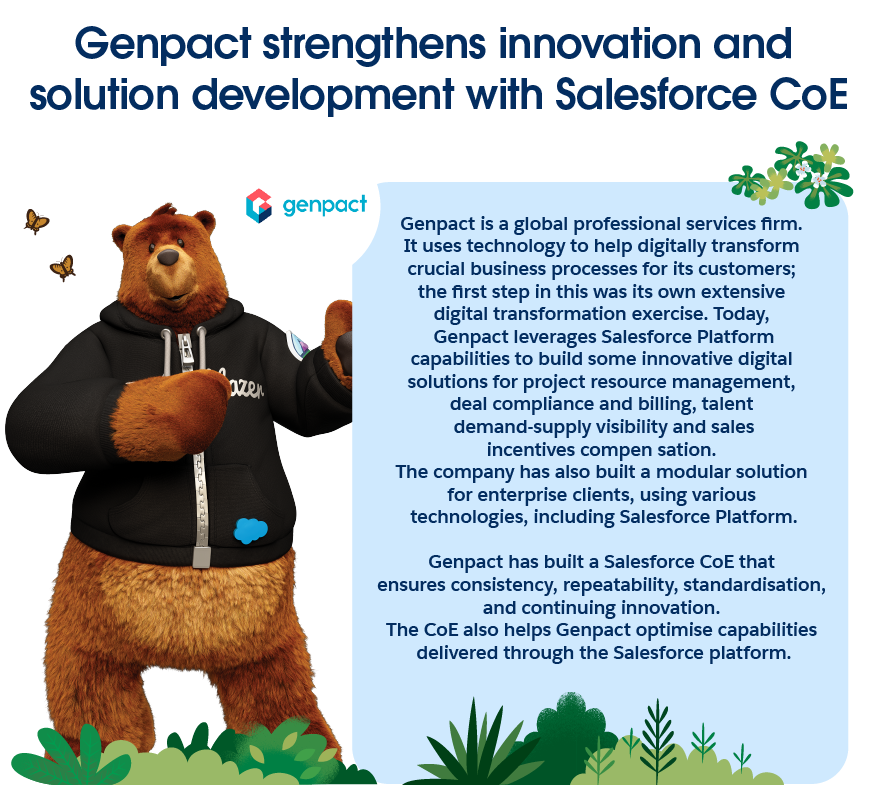Are you in the process of evaluating a Salesforce solution, or coming new to a Salesforce implementation?
Are you looking to leverage Salesforce architectures and best practices to integrate disparate systems, enhance user experience, see business value, speed up project delivery – all while ensuring reusability, scalability, and maintainability of solutions you choose?
Do you want to align your organisation’s digital transformation with its priorities, business goals, objectives, and success metrics?
As efficiency and customer-centricity become priorities, businesses like yours are rapidly digitising to stay ahead of the curve. This is driving up spending on cloud technologies; expected to reach $482 billion in 2022, with software as a service (SaaS) being the largest market segment. But according to a recent survey, only 29% of organisations are fully confident that their initiatives to switch to the cloud will deliver value in time. This shows that effective digital transformation (DX) needs more than just a good tech solution.
Challenges to successful digital transformation
Usually, different teams chase different DX goals. A CIO may focus on cybersecurity, but a sales or service head may want to see better lead conversion rates or case resolution times, respectively. And effective DX needs structure and planning to avoid delays and mismatched expectations.
Also, companies still relying on legacy systems need the right talent and technological know-how to drive their move to the cloud. This ensures business can run as usual while the transformation is ongoing.
A Salesforce centre of excellence (CoE) takes care of all such needs by filling skill gaps and bringing cohesion among different stakeholders so DX can deliver true business value. The CoE provides standardised processes, tools, governance frameworks, and best practices that help deliver DX projects in a structured manner. It also helps adopt new ways of working, revamped cultures, and innovation.
What is a Salesforce centre of excellence?
Broadly, a Salesforce CoE is a management framework that ensures timely DX. It understands the customer's DX and business goals and aligns all the other stakeholders – implementation partners, success management teams, external consultation partners – on these.
It provides governance, implementation, change, and risk management strategies, and DX best practices to make sure the project moves as planned and achieves all its goals. In tandem, it defines the roles and responsibilities of each stakeholder so everyone is extremely clear on how they contribute to the DX project.
A Salesforce CoE can have multiple layers. Some of these are:
- Programme management office: They oversee the programme from start to end and create strategies for collaboration and communication between teams, implementation, rollout timelines, etc.
- Business process organisation: Typically managed by the customers, they ensure business processes are clearly defined, set up, and mapped against the specific technological capabilities needed.
- Technology management team: These teams ensure smooth transitioning from existing to new systems. They provide roadmaps for developing and implementing tech solutions, data migration, integrations, etc., based on identified business processes.
- Change management office: Change management is typically led by the customer success team and involves participation from all relevant stakeholders to drive technology adoption and value.
Guiding principles behind a CoE include:
- Ensuring standardisation: Developing and documenting templates, blueprints, replicable processes and methodologies for important actions to ensure consistency and quality
- Managing assets: Identifying usable assets within the customer organisation and CoE. Assets can be physical or intellectual, including human resources, software artefacts, etc.
- Measuring performance: Building the capabilities to track, measure, and report the performance and outcomes of each team’s efforts. This is critical to a CoE’s growth and evolution, as clearly demonstrating success through measurable metrics help get the support and buy-in of stakeholders, particularly those in executive or leadership roles
- Providing governance: Giving approvals, besides guidance and suggestions, for significant decisions and actions
- Aligning SMEs: Identifying and aligning subject matter experts (SMEs) with specific skillsets and experience based on the customer’s DX needs.
When should a Salesforce CoE be adopted?
We recommend all our customers adopt a Salesforce CoE, particularly when they come from an on-premise mindset. CoEs can mean different things depending on the customer's goals and the in-house skillsets they have to manage different aspects of the project.
Some large enterprises already have internal CoEs. If they lack a specific role, like a technology architect or a programme manager, Salesforce can provide someone with the exact skillsets. But a small business may not have the in-house talent to fill any of the CoE roles. In this case, we take the customer through a review process to identify existing capabilities and gaps. Then, we provide talent with the required skillsets depending on the nature and extent of their DX needs.
Usually, the CoE is dissolved on the project's completion. But in some cases, customers continue to use a CoE to further develop their digital capabilities, ideate on and implement new innovations, and guide their business processes and systems.
Salesforce CoE benefits every business should know about
- Made up of highly-skilled, experienced professionals who lend their expert guidance to identify and onboard the right technology for any business.
- Works with the customer’s leadership team to understand their business goals, strategies, KPIs, etc., and aligns technology adoption plans with these to build stronger business and IT partnerships.
- Provides a platform to freely share feedback that enables course correction and improvement of transformation and business processes.
- Leverages customer feedback to make Salesforce solutions better with every update release cycle.
- Seeks advice from leadership teams and technology implementation experts to build risk mitigation strategies for the project’s successful completion.
- Maintains the highest industry standards to build robust internal systems that ensure the proper functioning of the technology adopted once it goes live.
How can you optimise your CoE’s impact?
To get the most out of a CoE, businesses need to:
- Know their needs and priorities - why they want to adopt a particular technological solution and how they expect it to impact their processes.
- Define the value they expect the CoE to deliver, like implementing a solution by a set date or sticking to a budget.
- List the services expected to be delivered by the CoE, like change management, building a programme strategy, defining the roles and skillsets required for each, etc.
- Identify which roles within the CoE they will provide, roles that need to be outsourced, and who will fund each of the defined roles.
- Tweak internal processes and upskill employees to effectively leverage technology.
- Assess current levels of technological maturity and set goals and timelines for the future.
- Set relevant success metrics you need to measured.
- Define the organisational structures needed to achieve expected outcomes.
- Build a plan of action for your organisation’s DX.
- Get buy-ins from the executive level.
The basic elements in most CoEs are the same. But when adopting Salesforce solutions, a Salesforce CoE can provide distinction in development standards, testing strategies, integration, etc.
Salesforce CoEs help customers successfully adopt Salesforce solutions while focusing on their business priorities, reducing risks, clearly communicating the product functionalities that will be built, and defining training strategies.
Digitalisation is no longer an option. To meet evolving customer demands, businesses must speed up their go-to-market times and reduce average development cycles. Adopting a CoE can enable businesses to go online in as few as six to ten weeks while also focusing on building digital capabilities for the future.





